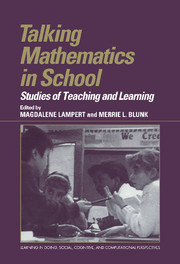Book contents
- Frontmatter
- Contents
- Series Foreword
- Acknowledgments
- List of Contributors
- 1 Introduction
- Part I Doing and Learning Mathematical Talk
- 2 Language Socialization in the Mathematics Classroom: Discourse Practices and Mathematical Thinking
- 3 The Role of Imagery and Discourse in Supporting Students' Mathematical Development
- 4 Building a Context for Mathematical Discussion
- 5 Disciplined Perception: Learning to See in Technoscience
- Part II Teaching Mathematical Talk
- Afterword
- Author Index
- Subject Index
5 - Disciplined Perception: Learning to See in Technoscience
Published online by Cambridge University Press: 04 August 2010
- Frontmatter
- Contents
- Series Foreword
- Acknowledgments
- List of Contributors
- 1 Introduction
- Part I Doing and Learning Mathematical Talk
- 2 Language Socialization in the Mathematics Classroom: Discourse Practices and Mathematical Thinking
- 3 The Role of Imagery and Discourse in Supporting Students' Mathematical Development
- 4 Building a Context for Mathematical Discussion
- 5 Disciplined Perception: Learning to See in Technoscience
- Part II Teaching Mathematical Talk
- Afterword
- Author Index
- Subject Index
Summary
It is futile to study perception “in itself.” It must be treated as a “phase of action” in relation to the motor and intellectual activity of the individual. … An object only affects behavior in so far as it has meaning, and this only arises from its functional relations to other objects, be they spatial or temporal relations, or relations of causality or purposiveness, etc. The problem of meaning, therefore, ultimately has priority over that of form.
Albert Michotte (1954)Let the use teach you the meaning.
Ludwig Wittgenstein (1953)Introduction
This chapter presents an approach to understanding how people learn and use their bodies to participate in the cultural practices of technoscience. Our analyses are organized around two detailed cases of embodied disciplinary knowledge drawn from two naturally occurring settings. The first case is a tutoring interaction involving an adult tutor and an adolescent student working together on school mathematics tasks involving the Cartesian coordinate system. The second case involves two civil engineers redesigning a roadway plan for a housing project using a more complex “coordinate system.” These case studies describe the development of what we call “disciplined perception.” This volume attests to the growing focus on talk in research on mathematics learning. As conversation and discourse analysts have argued over the last twenty years, “talk-in-interaction” (Schegloff, 1992) is a primary site for activity that makes, reproduces, and transforms our social and cognitive worlds.
- Type
- Chapter
- Information
- Talking Mathematics in SchoolStudies of Teaching and Learning, pp. 107 - 150Publisher: Cambridge University PressPrint publication year: 1998
- 138
- Cited by

